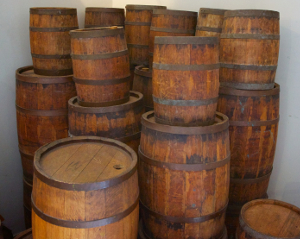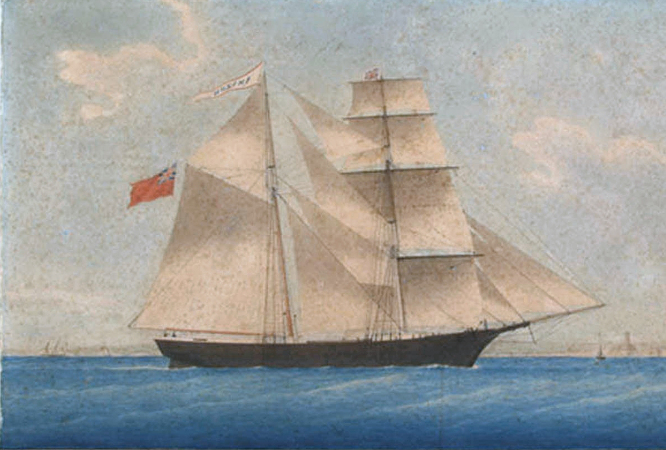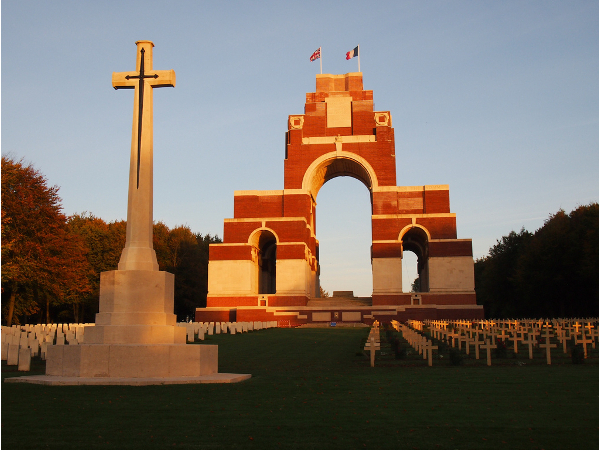The story of the Mary Celeste, a 282 ton brigantine, from which the captain, his wife and 2 year old daughter and 7 crews members disappeared some time before the 5th December 1872 is quite well known.
The ship had sailed from New York on 7th November that year with a cargo which included 1,700 barrels of industrial-grade alcohol in her hold, on her way to Genoa, Italy.
When found by the crew of the British brig Dei Gratia on 5th December 1872 she was 400 miles east of the Azores, drifting slowly towards the Straits of Gibraltar.
When the crew of the brig realized it was the Mary Celeste they were concerned as she had left New York 8 days before they had and should have already be safely berthed in Genoa.
The Dei Gratia changed course to offer help, the ship was in partial sail and in a sound and seaworthy condition.
There were ample provisions on board but when it was boarded it was found to be completely empty of the crew and passengers.
The last entry on the ship’s daily log, found in the mate’s cabin, was dated at 8:00 am on November 25, nine days earlier. It recorded Mary Celeste‘s position then as 37°01’N, 25°01’W, off Santa Maria Island in the Azores.
When both vessels arrived in Gibraltar the circumstances around the mystery were subject to a board of inquiry, normal procedure for an incident of this type, headed up by Sir James Cochrane, Chief Justice of Gibraltar, which commenced on 18th December 1872, Dec. 18, 1872.
The Attorney General of Gibraltar, Frederick Flood, who was also Advocate-General and Proctor for the Queen in Her Office of Admiralty was obstinate in pushing his conspiracy theories.
At first he insisted that the Captains of both vessels had conspired to share the salvage rights of the Mary Celeste.
The investigation: Uncovering clues and speculations:
This inquiry raised a number of possibilities of what may have occurred but was mainly driven by the inept Flood’s view that a crime had occurred, even though the inquiry revealed no evidence of such an act.
What was found, from the evidence of the crew of the Dei Gratia was all the evidence that was needed to piece together a logical solution to the mystery and come to a fair conclusion as to what had happened.
Instead of which, helped along by Flood’s apparent and complete inability to change his mind once it was made up and his suspicion of anything that the Dei Gratis crew said reinforced his assumptions and he would not change his opinion that a crime was behind the mystery.
When his insurance fraud conspiracy theory didn’t hold up he followed a course of trying to prove that the crew of the Dei Gratia had attacked the Mary Celeste, murdered and disposed of the crew and passengers and then ‘salvaged’ the vessel bringing it into Gibraltar to claim their prize.
Of all the unlucky vessels I ever heard of, she was the most unlucky
David Cartwright, a later owner of the Mary Celeste Tweet
The case trying to prove that theory was dismissed and the crew was found innocent, but Flood still suspected foul play and the aura of mystery has hung over the Mary Celeste ever since.
Even more so after Arthur Conan Doyle wrote a fictionalized version of the even in the style of a first-person account by a surviving crew member.
Since then conspiracy theories of the event have run rampant.
Apart from the idea of a criminal conspiracy between the captains and crews of the two ships and as the suspicions against the crew of the Dei Gratia acting alone have been dismissed there are a number of theories as to what happened.
Some outlandish and some which appear reasonable but do not really stand up to the evidence of the ship and the crew of the Dei Gratia.
Drunken Crew: Is this the answer to the mystery of the Mary Celeste?
It was found that 9 out of the 170 barrels of alcohol were empty. This theory speculates that the crew members would have consumed all the alcohol, got drunk and murdered the captain and his family for some reason.
More of the 9 barrels later but the alcohol was industrial grade, so methylated spirits, not fit for human consumption. Initial checks in Gibraltar found suspicious marks believed caused by an axe.
Nearby there were traces of what seemed to be blood. Further enquiry revealed the blood stains to be marks due to natural wear and tear.
Also the ships captain was a teetotaller and it is not likely that he would have allowed his crew drink either. He was also known to be an able and well behaved captain who was fair with his crew.
A little far fetched this one and goes into the same category as alien abduction and attack by a sea monster.
Some people have tried to link the Mary Celeste with this theory although there is no evidence that she sailed anywhere near the area and certainly she was found a thousand miles away.

Piracy theory:
There is absolutely no evidence that this occurred although it is often raised. The cargo was undisturbed as was the rest of the ship. There were personal items left on the ship which any self respecting pirate would have taken. There was no evidence that the ship was boarded or looted in any way and naval records indicate that there had been no incidents of pirates in the area for many years.
Natural Event: Could it be that simple?
There are some theories that a seaquake or a water spout may have been responsible.
I don’t think that this theory can be really considered because of a number of reasons.
There is evidence that the ship wasn’t damaged and no evidence that it had been tossed around in a manner to throw everyone over the side. Plates, cups utensils were all found neat and tidy within the hull, the cargo hadn’t shifted or been disturbed.
There was some evidence of water ingress into he hull but not enough to cause and immediate panic that the ship was floundering. The Captain and crew were experienced and I cannot imagine them abandoning a still floating vessel to take to the high seas in basically a lifeboat with a sail.
And what sort of father would subject his two-year-old to that peril unless the need was urgent, and there is no evidence that is was.
So What Did Happen? The enduring intrigue continues...
The short answer is that nobody knows, but that is a little obvious and doesn’t do anything to try and answer the questions.
There is some evidence which when put together allows a fair guess at what may have happened.
Remember the 9 barrels that were discovered empty? They were not empty because the crew had suddenly taken it upon themselves to get drunk. They were empty because they leaked and not as in the lid fell off but because they were the wrong barrels to store liquids in.
The other barrels in the hold had all been manufactured from white oak which by the nature of its structure is water tight when used for such a purpose.
White oak is used to store and transport liquids (like Bourbon). The 9 barrels that were found to be empty were made of red oak. Not a mistake but incorrect use.
Red oak barrels, because of the composition of the wood are not watertight and were supposed to be used to store dry goods.
For whatever reason 9 wrong barrels were loaded into the hull. They contained the same industrial alcohol as all the other barrels. I would surmise that the barrels had been filled shortly before loading or else the leakage through the wood would have been apparent.
Maybe a rush job to get loaded, short of a few barrels and the red oak ones were used without realising the consequences.

When the Mary Celeste was found there was evidence that the yawl, the lifeboat with sails, kept on top of the cabin had been deliberately and carefully launched, railings had been dropped for the purpose and a heavy rope was found trailing behind the ship.
The ship’s navigational equipment was missing and the deck covers to the hold had been removed, by the crew, which takes time.
It can be easily accepted then that the crew launched the yawl themselves and took themselves onto it and took station behind the ship that they voluntarily abandoned the Mary Celeste. But why?
There is a theory that an explosion caused by the alcohol had forced the crew from the ship but it is dismissed as there is no evidence of an explosion or fire. But I think that there was or at least the crew feared that there could be one.
The industrial alcohol leaking from the 9 red oak barrels would have evaporated quite quickly. I can find no record of how big these barrels actually were but I am guessing a modern equivalent of around 45 – 50 gallons, or around 225 litres. That would equate to about 400 gallons of industrial alcohol leaking into the hold, a little over 2,000 litres.
The leak would have been obvious, the smell would have pervaded the hold and the ship. The crew would not have fully understood what was happening unless they inspected the whole cargo.
They opened the deck hatches to vent the hold, maybe there was a flash fire which would have been terrifying to the crew but because of the nature of the fumes would have been over in milliseconds and not caused any damage.
Either way, the barrels leaked and the crew opened the hatches. As an extra precaution they launched the yawl and tethered themselves behind the ship and waited to see if the ship would explode or not. What happened then isn’t known but for whatever reason the yawl was let go and the Mary Celeste sailed on without them.
There were heavy seas at the time, not a great risk to a big vessel as they had left but very dangerous in the one they found themselves in. They foundered, the yawl sank and they were lost.
When the crew of the Dei Gratia came across the Mary Celeste they noted the condition of the ship, the deck covers, the signs that the yawl had been correctly launched, the hawser behind the ship. What they didn’t notice was any sign or smell of alcohol in the hold.
In the week since the crew had opened the hatches to vent the hold that is exactly what had happened. The alcohol in the 9 barrels had continued to seep through the wood until they were all empty.
The alcohol evaporated and the smells vented through the open hatches. All that was left behind were nine empty barrels and a mystery.
Looking at all the stories from numerous sites about this event and the research that has been done, I think that this theory is probably closest to the truth.
What do you think?




A whale hit the rudder . The shock was absorbed by the direction wheel and the man at the direction wheel was pushed on the compass housing . ( Newton = action-reaction ) .
The solution is in the rudder because the shock was transfered at the direction wheel and the man on this was ejected to the compass housing . But I think I have finally the good answer ; The ship collided with shoals . This explains the captain`s desire to go to the nearest island to have the hull of the ship inspected . This also explains the inverted sail to catch the wind blowing in the direction to help the ship to get out of there by itself . And that explains why we took such a big rope because it came from this sail . And why everyone got into the lifeboat to make the ship as light as possible so that it could break free . We will have taken a little water for a few hours in case it took that time . Backing up to free the ship will have done it faster than expected and it will have also turned on itself and this will either have stretched the rope wich held the lifeboat or would have broken it by twisting this rope . The ringing and the torn sail can be explained simply by the 10 days that the ship spent alone while nobody raised or lowered sails as needed . And the water in the hold gave the ship a lot of inertia absorbed by these sails . Finally , since the experts are divided on the vapors ( Or liquid ) of alcohol while basically nothing indicates a problem in this sense while the hatches and portholes were normally so I assumed that it was an illusion of mind and that it should not be taken into account . It was the long rope that made us interpret the false fact that we wanted to stay away from the ship . I was convinced that it was a whale that struck the rudder but the cursed supposed vapors did not fit anywhere in the reasoning . Helped by Google translation .
I stand corrected : It wasn`t a whale that hit the rudder but the ship ran aground on a shoal ! That explains almost all of this , even a large inverted sail tied up at the four corners to take advantage of the wind to take the ship off . We will have put everyone in the lifeboat to lignten the ship and help it to get itself free and we will have moored to the ship with a long rope that was avaiable . The ship will have moved very quickly by pivoting on itself so that the lifeboat quickly found itself behind the ship with all problems that this causes . . . . .As far as the alcohol emanations are concerned , nothing indicates that because the main hatch was closed so there was no firm will to ventilate . This was falsy concluded because of the long rope behind the ship . It was assumed that they were stupid to let themselves be dragged along knowing that the rope would not be strong enough BUT , HERE , we understand that it was an accident and carelessness because they were too sure of themselves .
Mary Celeste – The Solved Mystery of a Ghost Ship by Veronica Esagui, will be released for global distribution May 7th, 2023.